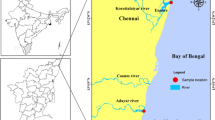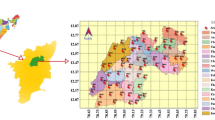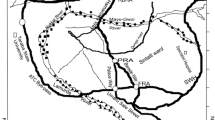Abstract
In the recent years, an environmental pollution plays a major role in the developing countries. In this study, the magnetic susceptibility meter was used to measure the low and high frequency susceptibilities to assess the ferromagnetic behaviour of Ponnai River Sand, Tamil Nadu, India. In the present study, all samples show that low frequency magnetic susceptibilities (χlf) are slightly greater than the high frequency magnetic susceptibilities (χhf). The textural characteristics, such as sand, silt and clay percentage were determined by mechanical sieve analysis. The content of the sand is varied from 78 to 92.30% with mean values of 84.46 whereas silt content varied from 6.20 to 21.50% with mean value of 14.20. The results show that sand concentration was dominated in all the sampling locations. Moreover content of sand, silt and clay is not altered by anthropogenic activities in the study area. In order to study the relation between textural characteristics and magnetic susceptibility, all the data were treated using multivariate statistical techniques such as factor analysis (FA), Pearson correlation (PC) and cluster analysis (CA) were performed to evaluate the anthropogenic inputs. Based on the obtained results, most of the samples show that moderate distribution of ferromagnetic minerals in the study area due to anthropogenic activities.





Similar content being viewed by others
References
Adam AMA, Eltayeb MAH (2012) Multivariate statistical analysis of radioactive variables in two phosphate ores from Sudan. J Environ Radioact 46:243–250. https://doi.org/10.1016/j.jenvrad.2011.11.021
Chan LS, Ng SL, Davis AM, Yim WWS, Yeung CH (2001) Magnetic properties and heavy-metal contents of contaminated seabed sediments of Penny’s bay, Hong Kong. Mar Pollut Bull 42(7):569–583. https://doi.org/10.1016/s0025-326x(00)00203-4
Chaparro MAE, Lirio JM, Nunez H, Gogorza CSG, Sinito AM (2005) Preliminary magnetic studies of lagoon and stream sediments from Chascom´ us area (Argentina) magnetic parameters as pollution indicators and some results of using an experimental method to separate magnetic phases. Environ Geol 49(1):30–43. https://doi.org/10.1007/s00254-005-0049-4
Chaparro MAE, Sinito MA, Ramasamy V, Marinelli C, Mullainathan S, Murugesan S (2008) Magnetic measurements and pollutants of sediments from Cauvery and Palaru River, India. Environ Geol 56:425–437. https://doi.org/10.1007/s00254-007-1180-1
Cristian JA, Jhony BB, Daniel I, Ospina S, Orlando ZE, Oscar OB, Carlos MG (2017) Relationship between physical properties and the magnetic susceptibility in two soils of Valle del Cauca. Soil Sci 34(2):33–45. https://doi.org/10.22267/rcia.173402.70
Dearing JA (1999) Environmental magnetic susceptibility, using the Bartington MS2 system, 2nd edn. Chi Publishing, Keniloworth
Dearing JA, Hay KL, Baban SMJ, Huddleston AS, Wellington EMH, Loveland PJ (1996) Magnetic susceptibility of soil: an evaluation of conflicting theories using a national data set. Geophys J Int 127:728–734. https://doi.org/10.1111/j.1365-246X.1996.tb04051.x
Gautam P, Blaha U, Appel E (2004) Investigation of magnetic properties and heavy metal chemistry to quantify environmental pollution in urban soils, Kathmandu, Nepal. Extended abstract: 19th Himalaya-Karakoram-Tibet worshop, Niseo, Japan
Geological Survey of India (1980) Technical report on systematic geological mapping in some parts of Chittoor District, Andhra Pradesh, India, GSI, Southern region, Hyderabad
Georgeaud VM, Rochette P, Ambrosi JP, Vandamme D, Williamson D (1997) Relationship between heavy metals and magnetic properties in a large polluted catchment: the Etang de Berre (South of France). Phys Chem Earth A 22(1–2):211–214. https://doi.org/10.1016/S0079-1946(97)00105-5
Golden N, Morrison L, Gibson PJ, Potito AP, Zhang C (2015) Spatial patterns of metal contamination and magnetic susceptibility of soils at an urban bonfire site. Appl Geochem 52:86–96. https://doi.org/10.1016/j.apgeochem.2014.11.004
Hu S, Wang Y, Appel E, Zhu Y, Hoffmann V, Shi C, Yu Y (2003) Magnetic responses to acidification in Lake Yangzonghai, SW China. Phys Chem Earth A/B/C 28:711–717. https://doi.org/10.1016/S1474-7065(03)00129-3
Jordanova DV, Hoffmann V, Thomas FK (2004) Mineral magnetic characterization of anthropogenic magnetic phases in the Danube River sediments (Bulgarian part). Earth Planet Sci Lett 221:71–89. https://doi.org/10.1016/S0012-821X(04)00074-3
Kanu MO, Meludu OC, Oniku SA (2014) Comparative study of top soil magnetic susceptibility variation based on some human activities. Geofis Int 53(4):411–423. https://doi.org/10.1016/S0016-7169(14)70075-3
Knab M, Hoffmann V, Petrovsky’ E, Kapicka A, Jordanova N, Appel E (2006) Surveying the anthropogenic impact of the Moldau River sediments and nearby soils using magnetic susceptibility. Environ Geol 49:527–535. https://doi.org/10.1007/s00254-005-0080-5
Liu QS, Maher BA, Yu Y, Deng CI, Zhu RX, Zhao XX (2005) Quantifying grain size distribution of pedogenic magnetite particles in chinese loess and its significance for pedogenesis. J Geophys Res 110(B11):1–7. https://doi.org/10.1029/2005JB003726
Petrovsky’ E, Kapicka A, Jordanova N, Knab M, Hoffmann V (2000) Low field susceptibility: a proxy method of estimating increased pollution of different environmental systems. Environ Geol 39(3–4):312–318. https://doi.org/10.1007/s002540050010
Punniyakotti J, Ponnusamy V (2017) Radionuclides of 238U, 232Th and 40K in beach sand of southern regions in Tamil Nadu State, India (Post-Tsunami). Indian J Pure Appl Phys 55:218–230
Ramasamy V, Suresh G, Venkatachalapathy R (2009) Magnetic susceptibility of the Ponnaiyar River sediments, Tamil Nadu, India. Glob J Environ Res 3(2):126–131
Ramasamy V, Paramasivam K, Suresh G, Jose MT (2014) Role of sediment characteristics on natural radiation level of the Vaigai River sediment, Tamil Nadu, India. J Environ Radioact 127:64–74. https://doi.org/10.1016/j.jenvrad.2013.09.010
Rao SY, Reddy TVK, Nayudu P (1997) Groundwater quality in the Niva River basin, Chittoor District, Andhra Pradesh. India Environ Geol 32(1):56–63
Ravisankar R, Tholkappian M, Chandrasekaran A, Eswaran P, El-Taher A (2019) Effects of physicochemical properties on heavy metal, magnetic susceptibility and natural radionuclides with statistical approach in the Chennai coastal sediment of east coast of Tamil Nadu, India. Appl Water Sci 9(151):1–12. https://doi.org/10.1007/s13201-019-1031-8
Sangode SJ, Vhatakar K, Patil SK, Meshram DC, Pawar NJ, Gudadhe SS, Badekar AG, Kumaravel V (2010) Magnetic susceptibility distribution in the soils of Pune Metropolitan region: Implications to soil magnetometry of anthropogenic loading. Curr Sci 98(4):516–527. https://doi.org/10.2307/24111703
Scholger R (1998) Heavy metal pollution monitoring by magnetic susceptibility measurements applied to sediments of the River Mur (Styria, Austria). Eur J Environ Eng Geophys 3:25–37
Thompson R, Oldfield F (1986) Environment magnetism. Allen and Unwin, London
Venkatachalapathy R, Veerasingam S, Basavaiah N, RamkumarT DK (2011) Environmental magnetic and geochemical characteristics of Chennai coastal sediments, Bay of Bengal. J Earth Syst Sci 120(5):885–895. https://doi.org/10.1007/s12040-011-0108-z
Yang T, Liu Q, Chan L, Liu Z (2007) Magnetic signature of heavy metal pollution of sediments: case study from the East Lake in Wuhan, China. Environ Geol 52:1639–1650. https://doi.org/10.1007/s00254-006-0609-2
Author information
Authors and Affiliations
Corresponding author
Additional information
Publisher's Note
Springer Nature remains neutral with regard to jurisdictional claims in published maps and institutional affiliations.
Rights and permissions
About this article
Cite this article
Senthil Kumar, C.K., Chandrasekaran, A. Multivariate statistical tool to analyse the environmental magnetic data in Ponnai River Sand, Tamil Nadu. Environ Earth Sci 79, 497 (2020). https://doi.org/10.1007/s12665-020-09241-7
Received:
Accepted:
Published:
DOI: https://doi.org/10.1007/s12665-020-09241-7




